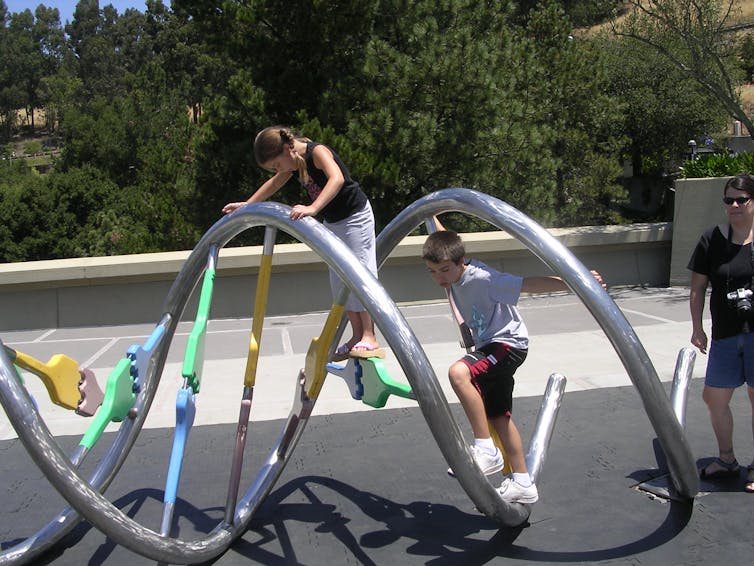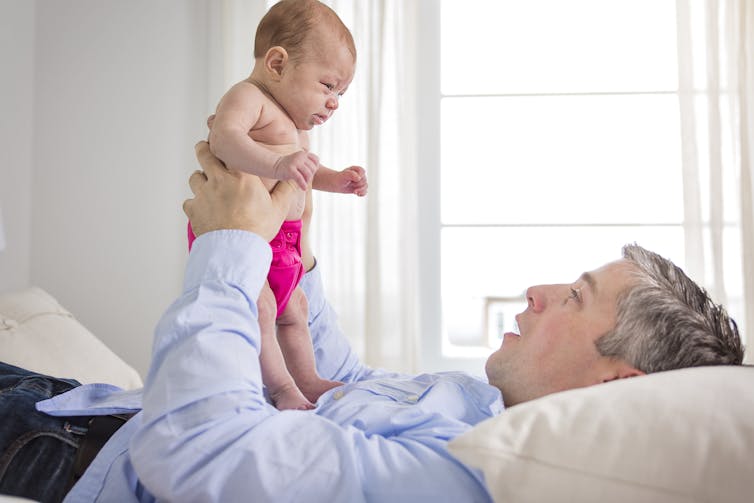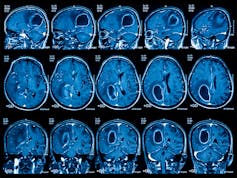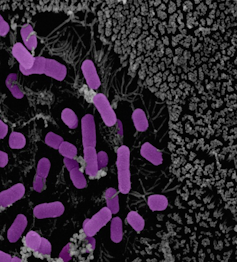
Andrew Whitehouse, The University of Western Australia
This is a long read, enjoy. Andrew will be answering reader questions from 4pm-5pm AEDST on Friday, February 19.
One of the great and enduring mysteries of autism is what causes the brain to develop so differently. The behavioural differences of many individuals with autism are so apparent that it seems intuitive that the causes would also be obvious.
But research over the past 70 years has indicated this isn’t so. Into this knowledge gap have come all sorts of weird and wacky ideas about the causes of autism: television, power lines, vaccines and sex position during conception. None have any credence, but have fuelled the mystery surrounding what may cause autism.
In the 1950s and 1960s, there was a widely held belief that autism was caused by parental coldness towards the child. The term “refrigerator mother” was often directed towards the mothers of these children.
Leo Kanner, the man who first described the behaviours that characterise autism, explored “a genuine lack of maternal warmth” as a possible explanation for autism. This inaccurate belief left a legacy of shame and guilt in the autism community for at least the following two decades.
Several eminent scientists eventually extinguished the myth. Two of them were themselves parents of children with autism, and they highlighted a major flaw in the theory: parents who fitted the “refrigerator” stereotype also had children who did not have autism.
Since this time, research has focused on biological factors that may lead to autistic behaviours. This has found very clearly there is no one cause of autism.
A variety of genetic factors are likely to be the ultimate cause of most cases of autism. These may work by themselves, or in combination with environmental factors, to lead a child’s brain to develop differently and result in autistic behaviours.
Genetics
To examine the influences of nature (genetics) and nurture (environment) on a given human quality, scientists study twins.
To appreciate how these studies work, it’s first important to understand there are two types of twins. Identical twins share all of their DNA and, assuming they grow up in the same household, they will also share all of their environment. Fraternal twins also share all of their environment, but only around half of their DNA, just like non-twin siblings.
Twin studies start by defining a clear population, say the metropolitan area of a city, and finding as many sets of twins as possible in that area where one or both of the twins have the given trait of interest – in this case, autism.
Scientists then look at the “concordance” of that trait – that is, the percentage chance that if one twin has autism, the other twin will also have autism. If the concordance is higher for identical twins than fraternal twins, then we can say the difference is due to the increased amount of genetic material shared by the identical twins, and that autism is influenced by genetics.

The first twin study of autism was conducted in 1977 on 11 identical and ten fraternal twins across Great Britain, where at least one of the twins had autism. Concordance for identical twins was 36%, compared to 0% for the fraternal twins.
While the study was only small in size, it provided the first evidence that autism may be genetic in origin. Since this pioneering study, more than a dozen further twin studies have confirmed this original observation.
The best current estimate is that there is a 50-80% concordance for identical twins and a 5-20% concordance for fraternal twins. This indicates a strong genetic component to the condition. The figure for fraternal twins – 5-20% – also represents the chance of a couple who already have a child with autism having a second child with autism (referred to as the “recurrence risk”).
Once scientists have established that the cause of a disorder is influenced by genes, the next task is to identify the exact genes that might be involved. However, after several decades of intensive research, scientists could find no one genetic mutation that all individuals diagnosed with autism shared.
It was these findings (or lack of findings) that led scientists to stop thinking of autism as one condition with one cause. They started viewing it as many different conditions which all have relatively similar behavioural symptoms.
This new view of autism has proved extremely fruitful in discovering subtypes of autism. For example, a number of conditions have very clear genetic or chromosomal abnormalities that can lead to autistic behaviours.
These include disorders that have abnormalities of the chromosomes, such as Down syndrome. While no chromosomal condition itself accounts for any more than 1% of individuals with autism, when combined they account for approximately 10-15% of all individuals diagnosed with autism.
The exact genetic abnormalities that may lead to the remaining cases of autism are not completely clear. There are two reasons for this.
The first is that the genetic regions involved are likely to be very complex. Scientists have needed to develop new techniques to examine them.
The second is that it is probable the genetic mutations are very rare and complex. The DNA chain that forms our chromosomes contains more than 3 billion building blocks. To identify small pieces of DNA that may be linked to the development of autism among so many base pairs, scientists need to study a very large number of people with autism.
To date, no study has been able to examine the thousands of people necessary to identify with accuracy all of the small mutations that might lead to autism.

However, with genetic technologies improving at an astronomical pace, as well as global scientific cooperation that will lead to large numbers of people being studied, major advances in the understanding of the causes of autism are likely in the very near future.
A likely prospect is that many cases of autism will be related to what is called “common genetic variation”. This refers to differences in genes that are also found in many individuals who do not have autism and which by themselves are not sufficient to lead to autism. However, when multiple genetic risk factors are found in the same person, they combine to have a major effect on how the brain develops.
A small proportion of autism cases are also likely to be caused by what are known as de novo (“new”) mutations. Most often, the egg and sperm that create a baby contain genetic material that is present in the mother and father, respectively. However, in rare cases, the egg and sperm may contain genetic material that is not found in either parent. There is now good evidence that some people with autism may have inherited de novo genetic mutations that have an effect on brain development.
Environmental causes
Recognition has grown over the past decade that aspects of our environment may also contribute to autism. However, despite substantial research, no one environmental factor has yet been found to be a definite cause of autism.
The most widely used research technique to examine environmental risk factors for autism is epidemiology, which examines how often, and why, diseases occur in different groups of people.
Several environmental factors during prenatal life have been linked with autism. Bacterial or viral infections in the mother during pregnancy have been found to slightly increase the risk of autism in the offspring. This could be due to the passage of harmful infectious organisms from the mother to the fetus through the placenta, or because the immune response of the mother may be detrimental to the developing brain of the fetus.

Other factors in the mother that may be related to offspring autism include a folic acid deficiency at the time of conception, the presence of gestational diabetes and the use of certain antidepressants during pregnancy, but no conclusive evidence exists for any of these links.
Being an older parent, particularly an older father, is also thought to increase the risk of having a child with autism. As males get older, the number of sperm that contain de novo genetic mutations increases.
Some of the de novo genetic mutations will have minimal or no effect on the resulting baby, but some mutations can lead to the brain developing differently.
Several studies have found that fathers who are over 50 at the time of conception have a greater chance of passing on de novo mutations and also a greater risk of having a child with autism.
An obvious, but very important, observation is that not all people who are exposed to these factors are diagnosed with autism. One possible explanation for this is a phenomenon called gene-environment interaction, which is when the genetic make-up of two different people leads them to respond differently to an environmental factor.
Brain development
For a considerable time scientists were searching for one clear brain difference that may lead to autistic behaviours. However, this hope has yet to be fulfilled, with few studies identifying brain characteristics that are shared by different individuals diagnosed with autism.
This may be a further indication that autism has many different causes, but it may also be a reflection of the difficulties in studying the brain.
Currently, scientists use a variety of clever techniques to understand the structure and function of the brain, such as magnetic fields, X-rays and radioactive chemicals. As ingenious as these methods are, they are unable to provide a full measure of the tremendous complexity of how the brain operates.

It is also unlikely that autism affects just one area of the brain alone. The complex behaviours of individuals with autism, which include cognitive, language and sensory difficulties, make it difficult to pinpoint just one brain region that may be affected. Nevertheless, some promising leads have shown how different brain pathways may lead to autistic behaviours.
There is increasing evidence that differences in brain development may begin prenatally in some individuals with autism. Several studies of prenatal ultrasound measurements have found evidence for differences in the growth patterns of the brain in foetuses later diagnosed with autism. Newborns later diagnosed with autism are often also reported to have large heads at birth (“macrocephaly”).
Another research technique has been to dissect the brains of individuals with autism who have prematurely died, so-called post-mortem studies. A recent study that examined the brains of 11 autistic individuals at the microscopic level found changes in the structure and organisation of the brain cells that form during foetal life, indicating differences in brain development that begin very soon after conception.
Another well-studied area in autism is head circumference growth in the first years of life. This research dates back to 1943 and Leo Kanner’s original study that found five of the 11 children with autism he examined had large heads.
Several small studies throughout the 1990s and 2000s searched the medical records of relatively small groups of children with autism. These found that a key period was the first two years of life, in which a minority of children later diagnosed with autism had a marked increase in the rate of growth of their head.
During the first two years of life, the size of an infant’s head is a reasonable indicator of total brain size, and for many years “brain overgrowth” during very early development was seen as a risk factor for a later diagnosis of autism.
However, more recently, this view has been challenged by the release of the largest ever study in this area, which found no link between infant head circumference growth and autism.

Studies using brain imaging machines have examined whether parts of the brains of individuals with autism may be different in size, shape or function.
However, the only consistent finding is just how much inconsistency there is. Not every individual with autism has differences in the size or pattern of growth of different brain regions. For those individuals who do, it is unclear how this may relate to their autistic behaviours.
A great deal of brain imaging research has examined the connections within the brain of individuals with autism. Connectivity is a measure of how well and how much two brain areas communicate with each other. In the study of autism, scientists distinguish between short-range connections (between neighbouring brain areas) and long-range connections (between brain areas further apart).
One prominent theory that has emerged from brain imaging studies is that some individuals with autism may have under-connectivity in long-range connections, but over-connectivity in short-range connections.
If found to be accurate, these brain differences may be able to explain why some individuals with autism have difficulties with complex tasks that require the integration of information from multiple brain regions (such as cognitive and social abilities), but have no difficulties, or even enhanced abilities, for tasks that require less integration across brain areas (such as sensory processing).
Other biological factors
There is preliminary evidence some but not all individuals with autism are exposed to higher levels of testosterone in the womb. Excessively high testosterone concentrations in the bloodstream can be harmful and cause cells to die, particularly within the brain, which is highly sensitive to changes in hormone levels.
One thought is that the pattern of cell death caused by high testosterone levels may alter brain development in a way that leads to autistic behaviours in childhood. This theory is still to be proven. Again, it is certain that not all individuals with autism are exposed to excessive levels of testosterone in the womb.

The link between gastrointestinal (“gut”) problems and autism is another scientific area that has received a great deal of attention. It is now well known that between 30% and 50% of individuals with autism experience significant gastrointestinal problems, such as diarrhoea, constipation and an irritable bowel.
It has long been a mystery why, but there is now extremely good evidence that the complex community of microbes in the gut plays an important role in human development and is essential for healthy immune and endocrine systems, as well as the brain.
Some scientists believe a disruption in the natural balance of these “good” bacteria may be a potential cause of autism. Antibiotics, for example, are commonly used with infants in Western societies and are known to kill “good bacteria” along with the “bad” bacteria for which they were prescribed.
A difference in the community of microbes, which humans have evolved to rely upon, may disrupt brain development and lead to autism. At the present time, the evidence for this potential cause of autism is not strong, but there will be substantial research in this area in coming years.
Autism has no one single cause, both in terms of genes and the brain. In a minority of cases, there are very clear genetic abnormalities that cause autism. In other cases, the genetic differences are more complex and yet to be discovered.
While there is currently no evidence for any environmental causes, it is possible subtle influences of the environment may affect individuals differently depending on their genetic make-up, leading to autism in some children. These relationships are also yet to be discovered.
Andrew will be on hand for an Author Q&A between 4 and 5pm AEDT on Friday, February 19, 2016. Post your questions in the comments section below.![]()
Andrew Whitehouse, Bennett Chair of Autism, Telethon Kids Institute, The University of Western Australia
This article is republished from The Conversation under a Creative Commons license. Read the original article.

